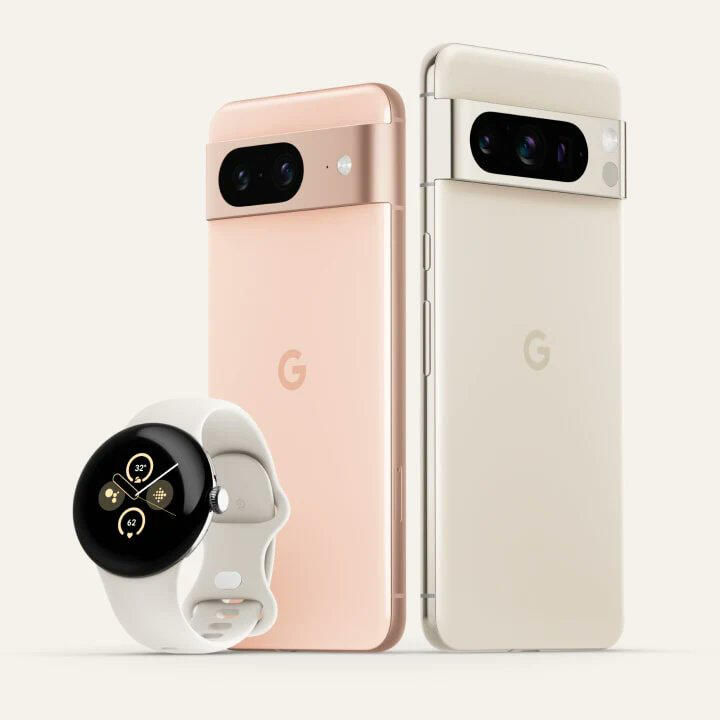Google’s highly anticipated October hardware event took place this week in New York City.
In its eighth year, the Pixel smartphone series has had a transformation, with the Pixel 8 and Pixel 8 Pro.
The Pixel 8 features a 6.2-inch screen, while the Pro model has the 6.7-inch display, both with rounded edges and eco-friendly 100 percent recycled aluminium frames. The OLED displays have been upgraded to peak brightness levels of 2,000 nits for Pixel 8 and 2,400 nits for Pixel 8 Pro, significantly enhancing outdoor visibility.
What Features Do The New Models Have?
Secure Face Authentication and Temperature Sensing
A standout feature is the face authentication, allowing users to access apps securely. Additionally, the Pixel 8 Pro introduces a unique temperature sensor, allowing users to measure the temperature of various objects.
Better Photography and Videography
The Pixel 8 has an upgraded 50-megapixel camera with enhanced light sensitivity, capturing sharper photos even in low-light conditions. Meanwhile, the Pro model features a multi-zone autofocus system and exclusive Pro camera mode, offering more customisation options for photography enthusiasts. Video Boost mode, available on Pixel 8 Pro, uses cloud processing to enhance low-light videos, outshining competitors like the iPhone 14 Pro.
Software Enhancements
Beyond hardware upgrades, the Pixel 8 series introduces a number of new software features. Google Assistant now has the ability to summarise and read aloud web pages. Other software innovations include Magic Editor in Google Photos and Audio Magic Eraser, removing unwanted sounds from videos.
Real Tone ensures accurate skin tones in videos, and Face Replacement allows effortless editing of group photos.
Extended Support and Sustainability: A Game-Changer
Seven-Year Software Support
Google’s Pixel 8 series sets a new industry standard with a new software policy: seven years of software support, encompassing both OS enhancements and security updates. This positions Google in direct competition with Apple, showcasing its commitment to longer device relevance and user satisfaction.
Sustainability Initiatives
In a bid to reduce environmental impact, the Pixel 8 and 8 Pro feature frames crafted from 100 percent recycled aluminium. While Google’s transition to sustainable materials makes a good statement, it also raises questions about the devices’ long-term repairability.
Pixel Watch 2: A Seamless Blend of Form and Functionality
Design and Performance
Google’s Pixel Watch 2 maintains its sleek design while introducing new features. The case, now crafted from 100 percent recycled aluminium, promises a more comfortable user experience due to its lighter build.
The watch runs on the new Wear 4 operating system, offering enhanced app functionality, including Gmail and Google Calendar integration.
Health and Safety Features
Incorporating advanced health tracking capabilities, the Pixel Watch 2 introduces a heart rate sensor, ensuring accurate readings during exercise.
Personal Safety features include emergency location sharing, Safety Check, and Safety Signal, empowering users with proactive safety measures. Additionally, the watch integrates a skin temperature sensor and a electrodermal activity sensor, providing valuable health insights and stress management tools.
Google Pixel Buds Pro: Elevating Audio Experience
More Connectivity and Awareness
Google’s flagship wireless earbuds, the Pixel Buds Pro, received notable updates. Bluetooth Super Wideband technology doubles voice bandwidth, enhancing call clarity significantly.
The Conversation Detection mode pauses music when users begin speaking, ensuring awareness of their surroundings. A low-latency gaming mode reduces audio latency, catering to gaming enthusiasts.
In conclusion, Google’s October hardware event shows a great leap in smartphone technology, photography, wearables, and audio experiences.
With its commitment to sustainability, extended software support, and innovative features, Google continues to push the boundaries of what’s possible in the tech industry. As these devices make their way into consumers’ hands, their impact on daily lives and the broader tech landscape will be closely watched.



